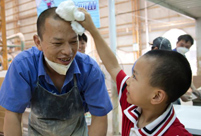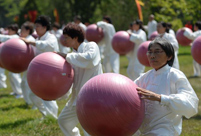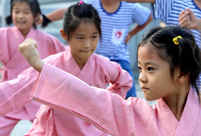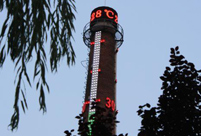XINING, Aug. 13 -- A zoo on the Qinghai-Tibet plateau has successfully bred a pair of snow leopard cubs, it announced on Wednesday.
The twins were born on June 14 in the Wildlife Park of Xining, capital of northwest China's Qinghai Province, but the zoo authorities waited two months to announce the birth of the cubs due to fears that they might not survive their first two months, said Qi Xinzhang, deputy curator of the zoo.
"The death rate of leopard newborns is very high in the first months after they are born. So it's an unwritten rule that we can only say the breeding program is a success after the cubs have emerged from the first two months in good health," said Qi.
The cubs are the first born of seven-year-old mother Er Bao and five-year-old father Ning Ning. Previously, the park successfully bred seven snow leopard cubs: three in 1984, a couple of twins in 1985 and another pair of twins in 2012.
"Snow leopards rarely care for newborns by themselves, and in 2012, the cubs were fed by our staff after they were born. But now with Er Bao feeding the newborns by herself, we can observe and study how a snow leopard brings up cubs. This is of great value for further artificial breeding programs," said Qi.
So far, the cubs have not faced any human contact for fear of disturbing them and the zoo doesn't even have any idea about their gender.
"We plan to introduce them to the public in the middle of September, when they are stronger and more bonded with their mother. Then, we can do a physical examination of the two and know their gender," said Qi.
To ensure sufficient nutrition after she gave birth, the zoo feeds Er Bao with milk, calcium tablets, cod-liver oil, eggs, mutton and pigeons. The two newborns can also eat some chopped mutton and pigeons after being weaned, said their keeper, Quan Shouyuan.
Xinhua reporters visited the snow leopard family on Wednesday in a secluded valley inside the park. Before entering the eight-square-meter enclosure where the leopards live, the reporters were required to put on the clothes usually worn by the keepers in case the unfamiliar smell would agitate the three.
Lying with the mother in a wooden box, the two newborns stared at the intruders curiously across the wire fence. With black spots dotted on their grey hair, the two youngsters quickly relaxed and played hide and seek around their vigilant mother, just like two spotty dogs.
"They grow up so fast that the box can not contain them anymore," said Quan, as he was peeling the fat out of gigots. "Cubs would get diarrhea after eating fat and drinking cold water," he explained.
To reduce human interference with the new family, Quan only enters the leopard den twice a day, to feed the cats and check their safety. The staff monitor the cubs' situation via camera the rest of the day.
Snow leopards are usually found in the Himalayan ranges of central and south Asia at altitudes between 3,000 and 5,500 meters.
The animal has rarely been seen in the wild since last century due to loss of their habitats and poaching. An estimated 3,500 to 7,000 snow leopards live in the wild, in addition to 600 to 700 more in zoos worldwide.
The species has been pushed to the brink of extinction by farmers protecting their livestock and hunters who sell its fur and body parts.
Around 2,000 to 2,500 wild snow leopards live in China's seven provinces and regions. The Xining Wildlife Park's artificial breeding of three cubs in 1984 marked China's first captive-breeding program for snow leopards. The zoo is now home to eight adult snow leopards, making it the largest facility of its kind in China.
 Beijing policewomen posters become a hit
Beijing policewomen posters become a hit Armored regiment trains on the sea
Armored regiment trains on the sea Children spend 'Father's Day' with dads at work
Children spend 'Father's Day' with dads at work 'Pan Da' appear in Shanghai World Financial Center
'Pan Da' appear in Shanghai World Financial Center Champions take selfies on podium
Champions take selfies on podium National Fitness Day celebrated around China
National Fitness Day celebrated around China Traditional culture colors summer vacation
Traditional culture colors summer vacation Young athletes fighting for their dreams
Young athletes fighting for their dreams 68 meters high thermometer in Shanxi, called ‘fighter’ of thermometers
68 meters high thermometer in Shanxi, called ‘fighter’ of thermometers The vanishing folk skills
The vanishing folk skills Intoxicating beauty of Dali, Yunnan province
Intoxicating beauty of Dali, Yunnan province Memorable moments of Ludian earthquake
Memorable moments of Ludian earthquake Bring world together to help elephant
Bring world together to help elephant 'Building Dreams'
'Building Dreams'  Labrang Monastery
Labrang MonasteryDay|Week|Month